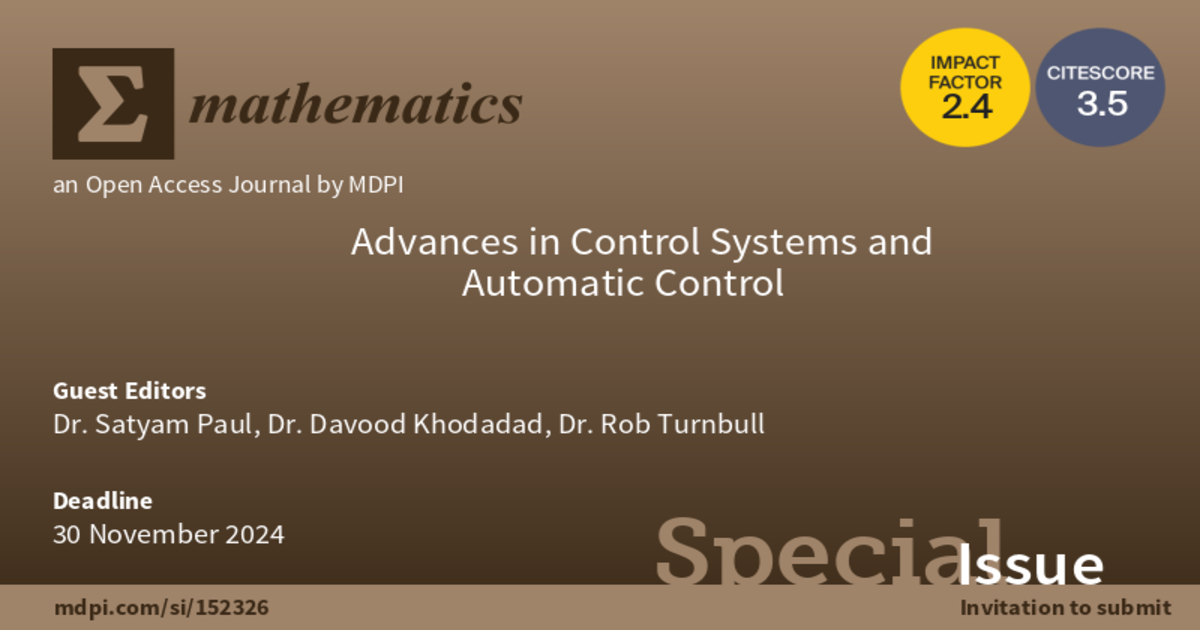Advances in Control Systems and Automatic Control
A special issue of Mathematics (ISSN 2227-7390). This special issue belongs to the section "Computational and Applied Mathematics".
Deadline for manuscript submissions: 30 November 2024 | Viewed by 19186

Special Issue Editors
Interests: control systems; active vibration control; fuzzy control; control algorithms; automatic fault detection
Interests: signal and image analysis; imaging systems; digital holography; speckle metrology; optical metrology
Special Issues, Collections and Topics in MDPI journals
Special Issue Information
Dear Colleagues,
Advances in digital processing hardware have resulted in faster sampling rates and provided the opportunity for control schemes with ever-increasing complexity to be developed. The use of control systems and automation has drastically increased over the past few years, setting a trend that is likely to continue into the future. The practical relevance of control systems is now possible due to advancements in sensors, actuators, control algorithms, and the application of machine learning. Control systems must carry out a variety of difficult activities in unpredictable working conditions, either with or without the assistance of human operators. In order to accomplish this, newly developed sensing, actuation, and control technologies have been thoroughly incorporated into increasingly sophisticated automated systems. This combined complexity creates significant difficulties for modern automatic systems. With intelligent control and cutting-edge technologies, significant advancements in automation are anticipated.
The purpose of this Special Issue is to give subject matter specialists a forum to work on an innovative control strategy. It will cover every facet of control engineering, including system identification, design, implementation, and analysis, for real-world control systems. Applications in mechatronic systems, robotics, automated manufacturing, power, aerospace, automotive, and electronic systems, among others, may be included in this Special Issue. Topics might include but are not limited to:
- Nonlinear, adaptive, and robust control;
- Current trends in PID;
- Vibration control;
- Fault detection;
- Machine learning in control systems;
- Model-based control;
- Model predictive control (MPC);
- System identification;
- Fuzzy control.
Dr. Satyam Paul
Dr. Davood Khodadad
Dr. Rob Turnbull
Guest Editors
Manuscript Submission Information
Manuscripts should be submitted online at www.mdpi.com by registering and logging in to this website. Once you are registered, click here to go to the submission form. Manuscripts can be submitted until the deadline. All submissions that pass pre-check are peer-reviewed. Accepted papers will be published continuously in the journal (as soon as accepted) and will be listed together on the special issue website. Research articles, review articles as well as short communications are invited. For planned papers, a title and short abstract (about 100 words) can be sent to the Editorial Office for announcement on this website.
Submitted manuscripts should not have been published previously, nor be under consideration for publication elsewhere (except conference proceedings papers). All manuscripts are thoroughly refereed through a single-blind peer-review process. A guide for authors and other relevant information for submission of manuscripts is available on the Instructions for Authors page. Mathematics is an international peer-reviewed open access semimonthly journal published by MDPI.
Please visit the Instructions for Authors page before submitting a manuscript. The Article Processing Charge (APC) for publication in this open access journal is 2600 CHF (Swiss Francs). Submitted papers should be well formatted and use good English. Authors may use MDPI's English editing service prior to publication or during author revisions.
Keywords
- proportional–derivative (PD)
- proportional–integral–derivative (PID)
- fuzzy logic
- neural network
- artificial intelligence
- automation
- control engineering
- automatic fault detection







